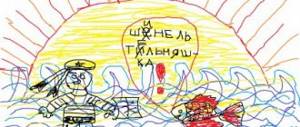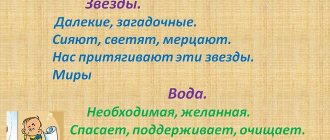Tasks
- Develop the ability to analyze, systematize, generalize, draw conclusions, and compare.
- To consolidate the knowledge about arthropods acquired in previous lessons, to instill communication skills;
- Cultivate interest in the subject and respect for nature.
Lesson type: lesson on accounting and control of ZUN.
Type of lesson : lesson game.
Form of work : group.
Teaching aids : drawings with images of insects, task cards, presentation slides.
During the classes
Organizing time.
Today in class we will repeat and summarize what we have learned about arthropods. The unusual thing about the lesson is that we will be divided into teams, and the repetition will take place in the form of a game. Let's play brain ring. The team selects an area and a question number to answer. If a team fails to complete the task, the right to respond is given to the other team that raised its hand first. Let's start the game. First, we'll draw lots.
Structure
| Function | Classification _ | Meaning | Team | |
| 1 | 1 | 1 | 1 | 1 |
| 2 | 2 | 2 | 2 | 2 |
| 3 | 3 | 3 | 3 | 3 |
| 4 | 4 | 4 | 4 | 4 |
| 5 | 5 | 5 | 5 | 5 |
| 6 | 6 | 6 | 6 | 6 |
| 7 | 7 | 7 | 7 | Game conditions |
Area "Building"
- Name the parts of the body shown in the picture.
- Name the types of insect limbs. Give examples of which insects have such limbs.
- What is the difference in the external structure of a cross spider and a scorpion?
- How is the exoskeleton of arthropods formed and what function does it perform?
- Name the characteristic features of arachnids, crustaceans, and insects.
- What is the structure of the circulatory system of arthropods?
- What is the difference in the structure of the circulatory system of spiders, crayfish, and insects?
- Name the organs located on the fly's chest.
- Name the type of nervous system of arthropods, what parts does it consist of?
Function area
- What function does the circulatory system of arthropods perform?
- What structure do cancer eyes have and what function do they perform?
- What function do antennas and antenules perform?
- How did the cross spider adapt to hunt, and how does the spider weave a hunting web?
- What is hemolymph and what is its function?
- What functions do the different limbs of crayfish perform?
- What function do the limbs of the insects shown in the picture perform?
Area "Importance of Arthropods"
- Why are crayfish called the orderlies of reservoirs?
- Who is the causative agent of scabies and encephalitis?
- What social insects do you know, and why are they called that?
- What role do bees play in human life?
- What precautions do you know to protect yourself from ticks?
- How are spiders useful?
- What is the role of ticks in nature and human life?
- What is the role of insects in nature and for humans?
- What poisonous spiders do you know?
Classification area
- Write down the classification of the phylum Arthropods
- Name the orders of insects and their representatives.
- Write down the classification of arachnids
- Write down the classification of crustaceans.
- Write down the classification of the bed bug species.
- Write down the classification of the common mosquito species
Team task. "Finish the sentence"
Print for each team.
- Body cover of arthropods...
- The body of most arthropods consists of ... ..., ... ... .... .
- The olfactory organs of most arthropods...
- Respiratory organs of arthropods...
- The circulatory system of arthropods….
- Spiders have poisonous...
- The excretory organs of arthropods are represented by...,...,....
- Decapods have eyes...
- Insect antennae are organs... and....
- Insects have... pairs of limbs.
2nd team task. Riddles competition.
- You won’t find strong men like these in this world, such a working family! Who is this
- I grow like a worm, I eat a leaf. Then I fall asleep and wrap myself. I don’t eat, I don’t look, I lie motionless. But with the new spring I suddenly come to life, I leave my home, I flutter like a bird.
- Not an animal, not a bird, But the nose is like a knitting needle.
- A violinist lives in a meadow, wears tailcoats and gallops around.
- A helicopter landed on a meadow clover - Golden eyes Who is it?
3 team task. Fill out the table.
| Structural features of arthropods | crustaceans | arachnids | insects |
| Body parts | |||
| Number of legs | |||
| Number of antennae | |||
| Organ of vision | |||
| Features of the structure of the circulatory system | |||
| Features of the structure of the nervous system | |||
| Respiratory system | |||
| Excretory organs |
4 team task. "Attention! Wanted!
Each team is a police department. I am turning to you for help. Help find a dangerous criminal. (It is necessary to describe it as accurately as possible, i.e. create a “photo composite” of the insect).
At the end of the lesson, the results are summed up, for this you can use evaluation sheets.
Biology game for grades 6-7 “These wonderful animals”
Extracurricular activity in biology grades 6-7
This event can be held during biology week.
Participants are divided into teams in advance, which receive a home task: prepare for the competition “team presentation”, “musical break”. To play the game you need: 1. Video projector, 8-10 slides with various animals (predators), an image of a baboon, insects, snakes.
2. Task cards for participating teams, envelopes, tokens for spectators, score sheet for the jury. Progress of the game:
Presenter: Today we have an unusual event, at which you will need the knowledge acquired in biology lessons.
But remember that the most complete, most accurate knowledge of nature lies beyond school textbooks, and is based on observations of the lives of living beings in everyday life. This requires such qualities as observation, the ability to notice the characteristic features of an animal, establish the relationship between phenomena, reflect, put oneself in the place of a living creature and see the world through its eyes. Our ancestors mastered these skills perfectly. After all, they were closely connected with the animal world - you had to know what animals and how to hunt, and which ones a person himself could serve as a good meal. Later, all the knowledge helped to train some animals. Unfortunately, today most people living in the city have lost, along with the need for everyday study of nature, an understanding of the laws of its existence. But the ability to observe and think will help us again understand the laws of existence of living beings. This is needed now more than ever. At today's game we will learn a lot of new things about the animal world. Well, since we cannot invite every representative of the animal world to our event, video recordings will help us make observations. So, let us consider our event dedicated to animals open. Let's plunge into the world of amazing, wonderful, diverse animals. Competition 1. Presentation of teams. (homework)
Presenter: A man, watching animals, dreamed of acquiring some of their qualities: the visual acuity of an eagle, the flight speed of a falcon or the running of a cheetah, the strength of a bear, the agility of a leopard.
Our ancestors not only hunted animals. They deified them. For example, in the Congo, some tribes consider elephants their ancestors, in Madagascar - crocodiles, and in modern Japan, fireflies are considered the souls of warriors who gave their lives for their homeland. Therefore, the first task is to find your totem. You must choose a name for your team and explain why you chose it. The teams come out and introduce themselves one by one. Their performances are evaluated by a jury. Maximum 5 points. Competition 2. The most attentive.
Host: The most important quality in today's game is observation. Now we have to find out who is the most attentive and observant. Various animals will be shown on the screen for a few seconds. Your task is to have time to recognize, remember, and then name as many of them as possible, as well as notice a common feature that is characteristic of all. 8-10 slides with images of various animals are shown on the screen, each slide lasting 3-5 seconds. You are given 1 minute to prepare an answer.
Each correct answer is scored 1 point (Slides: dolphin, penguin, coyote, frog, heron, crocodile, polar bear, swimming beetle. Characteristic feature: predation)
Competition 3. Problem solving.
Host: In this competition you will need the ability to make connections. Each team receives one task. The teams draw lots, after which they open the envelopes and get to work. Preparation time: 3 minutes. The audience at this moment takes part in the quiz. After the quiz, the presenter reads out the task of each team in turn and listens to its answer. Then he gives the correct answer and the corresponding video fragment is shown. If the team finds it difficult to answer a question, you can use the hints provided, thereby reducing points. The maximum score is 5 points. Contents of the cards: TAILED WATCHMAN
(On the screen there is an image of baboons.) To date, about 100 species of ancient gymnosperms - cycads - have been preserved.
Encephalartos is one of the most interesting species, but it is endangered. The seeds of this plant are a tasty food for elephants and baboon monkeys (the monkeys also eat the seedlings). Scientists have proposed an unexpected solution - to breed lions in this area. Explain the proposal. (Lions will regulate the number of monkeys) THE EYE SEES, YES THE TOOTH MET
(On the screen are representatives of the class of insects) The housefly has two large compound eyes and three simple ones, but, despite the abundance of eyes, the fly sees clearly only at a distance of 40-70 cm. A The dragonfly sees further - 1.5-2 meters.
Find the reason for the differences in “farsightedness” and explain it. Tip:
Differences in farsightedness are related to lifestyle.
(The dragonfly is a predator; it catches insects in flight, navigating with the help of its visual organs. This is not necessary for flies, since they feed on “stationary” food.) KEEP YOUR MOUTH WIDER
On summer nights, many mosquitoes and midges fly around.
This is an excellent food for fish on a fishing collective farm. But how will they end up in the water? Hint:
The midge itself flies into the water.
(the fish are fed using a spotlight: a beam of light is directed into the water, the midge, flying towards the light, falls into the water. The fish can only open their mouths.) HOW TO WARM CHILDREN
(snakes on the screen) The female tiger python collects 40-50 eggs in a pile and wraps itself around around the masonry, making 3-4 rings.
It turns out to be a living “jug” filled with snake eggs. It is known that pythons are cold-blooded animals, i.e. their body temperature does not rise above the ambient temperature. A python can only warm itself by forcing its muscles to work. Knowing this, naturalists of the last century believed that the mother was simply protecting her offspring. But having measured the body temperature between the rings of the female “sitting” on the eggs, we realized that she not only protects them, but also warms them. The temperature of the snake when it digests food can be 6-7 degrees higher than the air temperature. However, for normal development of eggs, a temperature of 35C is required. What should I do? (A lot of heat is generated in the python’s huge body, more than half consisting of muscles. Zoo visitors can watch how the snake, “sitting on its eggs,” regularly shudders its whole body.) Quiz with spectators: Each correct answer is worth 1 point (token ).
1. What feeds the wolf? (legs) 2. What animal can breathe in three ways: lungs, skin, mouth? (frog) 3. What is crawling? (the top layer of snake skin, which peels off when molting) 4. The name of which bird in the ancient Russian account corresponded to 10 million? (raven) 5. Which animal is the largest predator on land? (polar bear) 6. Can a polar bear eat a penguin? (no, they do not occur in nature) 7. What should you not feed the nightingale? (fables) 8. What animals are used to treat high blood pressure, eye diseases, and blocked veins? (leeches) 9. In what habitat do the fastest animals live? Name them. (Ground-air: swift, falcon, cheetah) 10. This bird is not small, but it is not easy to see: it will sit on the ground or a branch and disappear. That's just the color of it - pockmarked. Who is this? (hazel grouse) 11. Why does a sitting butterfly fold its wings? (a method of camouflage - in this case, it is positioned in relation to the sun so as not to cast shadows.) 12. These beetles fly in both spring and summer. What spring and summer months are their names associated with? (May and June Khrushchi) 13. This bird is a real acrobat, only it can run up and down a tree trunk. Who is this? (nuthatch) 14. Is this bird not like others - its beak is crisscrossed, and it can hatch chicks even in winter? (crossbill. Because even in winter it can feed the chicks with pine and spruce seeds) 15. Which insect can be called a “heavyweight” (ant) 16. There is such an expression - “ant cows”. Who is this and why do they call it that? (aphids. Ants feed on the sweet secretions of aphids and “graze” these insects, protecting them from enemies.) 17. Your age can always be found out by your birth certificate or passport. What serves as a “passport” for fish? (scales. By counting the number of rings on it, you can determine the age of the fish.) 18. There is an expression: “Those born to crawl cannot fly.” Is this so? Prove your point. (no. There are a flying tree snake (South America), a flying dragon lizard (Southeast Asia)) 19. Who “sees” with their ears? (Bat) Competition 4. Find out the portrait.
Presenter: During the filming of a video about nature, they forgot to sign which animals were filmed on videotapes, but they included their description. Your task is to recognize the animal by description, and then we will compare your answers with video portraits. All teams play at the same time. The description of the animal is read out in parts, after each part the responses of the teams are heard. Moreover, if the animal is recognized after the first reading, the team is awarded 6 points, after the second - 4 points, after the third - 2 points. After the teams answer, a video slide is shown and the correct answer is called. DESCRIPTION 1
1. These active birds delight the inhabitants of Great Britain, France, Germany with their chirping... They are often found in Japan and China. Their life is closely connected with trees, which is why they have tenacious legs with short claws.
The thin, awl-shaped beak is an excellent tool for catching insects and their larvae in the bark. 2. These birds are hollow nesters. Each litter contains from 6 to 15 insatiable yellow-throated babies. During the summer season, such a family eats more than 130 caterpillars. 3. At the end of summer, these birds gather in flocks. In the fall they move to human habitation. In winter, feeders are a great help for them. (great tit) Description 2
1. This is a beast.
His legs are long, almost like a giraffe's. Vegetable food. It has a very mobile upper lip, but it is not an elephant. The hair on the belly grows forward. 2. Thanks to the membrane on its hind legs, it easily walks through the muddy swamp. Can swim across the river. This forest animal. 3. His appetite is enviable - he digests up to 7 tons of food in a year. Can eat pine needles, horsetails, buttercups. And mukhamoromi is treated for worms. In addition to humans, wolves, bears, and the racer are dangerous for him. (elk) Description 3
1. This animal is small - from 50 cm to 1 m in length. Lives in forests and forest-steppes. The main food of young animals is insects. Adults feed on rodents. People are afraid and avoided. These animals regulate the number of rodents. 2. They sense the approach of cold weather very well. They overwinter in empty burrows.3. They can be gray, brown, green, but always have a wavy or zigzag line running along the back. This is the only poisonous snake common in Russia. (common viper)
Competition 5. Clever hunter.
Both teams and spectators are allowed to participate.
Presenter: Every hunter needs knowledge of habits, strength, dexterity, and fearlessness. Man used various devices to catch animals. We also can’t do without gear. Tell us who and how you can catch using a garden watering can. Discussion of the question is 1 minute, then answers are accepted. The maximum score is 10 points. (This animal is an earthworm. If you water the soil in the garden well, the worms will come to the surface, since they breathe atmospheric air.)
If there is no correct answer, they ask the bravest person to take this animal out of the box without looking.
For courage, the team is awarded 2 points. Musical break While the points are being counted, the teams show their number, which they prepared at home.
Game results
The chairman of the jury sums up the results, announces the team with the most points, and the game participants are awarded.
We recommend watching:
Extracurricular event in biology for Bird Day, grades 5-7 Brain-ring in biology for high school students Didactic game in biology with your own hands. Biological Lotto An intellectual game in biology for grades 7-8. Scenario
Similar articles:
Extracurricular activity in biology grades 6-7
Biology journey game for 8th grade
Extracurricular event in college biology on the topic “Guess the plant”
Biology game, 6th grade
Biology erudite competition, grades 6-7





